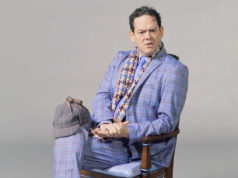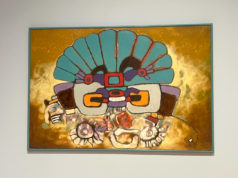Spread across the museum’s 4,600-square-foot Special Exhibitions Gallery, the show unfolds chronologically. New, mostly color, wannabe-arty stuff in the back. Old, mostly black-and-white, supposedly purely informative stuff up front. One of the first daguerreotypes ever made in America is here. As a work of art, the untitled portrait of two Philadelphia doctors (circa 1840) isn’t exactly thrilling, naturally. As a one-of-a-kind manifestation of Progress, however, the frail object has heavy circumstantial power. Steamboats, Gatling guns, Mark Twain — they’re all there, in the good doctors’ bemused expressions.
The photo is one of a handful of daguerreotypes on display. The rest of the show is made up of prints, some from series as small as a handful and others from much larger runs. (A print’s significance is not determined solely by the size of the series to which it belongs.)
One old print derives its worth not from being timeless but, oddly enough, from being trapped in time. No one would confuse Carl Mydans’ “The Japanese Surrender on the USS Missouri in Tokyo Bay, September 2, 1945” with arty photography. The contrast between lights and darks is anemic, and the content — a Japanese man signing a sheet of paper on a large ship surrounded by uniformed white men who all look like your bachelor uncle Larry — does not make for hot photographic action. Mydans had clearly tossed traditional notions of beauty overboard before steadying his gaze in the viewfinder.
Moreover, the photo comes up short as great journalism. Even if Mydans and the two or three other photogs onboard hadn’t captured the moment, chief commander of the Japanese army, Yoshijiro Umezu, still would’ve bowed — unintentionally — to a standing Gen. Douglas MacArthur to sign the treaty; the war still would have ended. Unlike Alan Diaz’ 2000 photo of Elian Gonzalez and an armed U.S. federal agent, “Japanese Surrender” does not do what great photojournalism is supposed to: provide counterpoint to received wisdom, illuminate, and engage. Newspaper stories at the time probably said more.
Though Amon Carter photography curator John Rohrbach would bristle at the thought, here’s the most logical reason Mydans’ photo was selected from the museum’s collection of more than 30,000: “Japanese Surrender” is history itself, a look into one of the most momentous occasions in recent memory and a subtle reminder of how far war journalism has come, from a couple of photogs on a boat to round-the-clock live video.
Household names imbue a few other pics with historical cachet: Albert Einstein, Marilyn Monroe, and John F. Kennedy as subjects; Walker Evans, Alfred Stieglitz, Ansel Adams, Gordon Parks, Diane Arbus, and Richard Avedon as contributing artists. The celebrities are treated kindly, and each print lives up to its creator’s reputation. Yet aside from the Avedon, a portrait he took on commission from the Amon Carter as part of his controversial In the American West project (1985), all of the majors’ contributions are out of character. The Evans isn’t a portrait of a poor, white bumpkin from Let Us Now Praise Famous Men, his and writer James Agee’s 1941 nonfiction Dust Bowl epic. Rather, the photo is of a storefront — more precisely, a storefront that Evans coyly warps into a geometric abstraction by pulling tight focus.
Similarly, while the Arbus, true to form, is genuinely creepy, it’s from before she really found her voice as a sympathetic portraitist of freaks. Even the Adams fails his brand of air-brushed naturalism. You may find more utopian, pastoral, and Adamsesque vistas on the sides of muscle vans.
Lesser lights account for two of 100’s several undisputed landmarks: Lewis Hines’ “Steamfitter” (a.k.a. Powerhouse Mechanic) from 1921, a crisp black-and-white profile of a muscular man in his undershirt seen from the waist up, leaning over in front of a large, sealed valve and tightening a bolt with a massive wrench; and Keith Carter’s “Fireflies” (1992), a blurry, haunting profile of two half-naked boys standing beneath sagging trees in the shallows of a body of water. The barely visible glass jar in the kids’ hands somehow staunchly defends its lofty place in the center of the image.
“Steamfitter” is the signature photo from Hines’ Men at Work project, a gritty masterstroke whose influence eventually transcended paper to affect celluloid (Fritz Lang’s Metropolis), canvas (Fernand Léger), and, most recently and perversely, cathode rays (the video for Madonna’s “Express Yourself”). The sweeter image, Carter’s “Fireflies” has for years appeared in one form or another on greeting cards.
Nearly every photo in the show is from a larger thematic series. Some are crown jewels. Taken on commission for the Stehli Silk Corporation, Edward Steichen’s “Stehli Silk Design” (1926) zooms in on dozens of matches arranged on a lightly hued tablecloth in patterns that suggest a fireworks display. Two other iconic prints, from different series, are Anton Bruehl’s “Harlem Number, at the Versailles Café” (1943), a candid of a stylishly dressed African-American couple dancing that Bruehl took for Esquire magazine, and Frank Gohlke’s “Grain Elevator and Lightning Flash, Lamesa, Texas” (1975), the frontispiece of his book on the Midwest, Measure of Emptiness (1992).
The best part about 100: looking at supposedly purely informative pictures and discovering art. In the late 1800s, before the camera outgrew its prosaic fundamental purpose as a tool, naturalists sent photogs west to bring the lay of the land back east. With names like “Vernal Fall and Nevada Fall from Glacier Point, Yosemite” (circa 1865) and “Malakoff Diggings, North Bloomfield Nevada County” (1871), the two most effective Carleton E. Watkins photos here might not sound terribly sexy. But when you see them, and notice the precision with which they were framed and developed, and realize their importance as reminders of a hopelessly optimistic time in American history, their timid, sad, brutal beauty slouches softly into focus. Watkins’ “Yosemite,” the crags cracking and curving like an old farmhand’s weathered palms, helped persuade the government to preserve the area, and “Malakoff” could pass as an experiment in neo-Dadaist legerdemain. Against the vast, bleached backdrop of what appears to be a limestone pit, the black pipe that monopolizes the foreground looks as unimposing as a tree branch. A tiny shack in the background, though, throws into relief the pipe’s actual, massive size.
Two locals here hold their own: Tarrant County College’s Peter Feresten (“Altar Call, Truth Tabernacle, Fort Worth,” 1978), and Texas Christian University’s Luther Smith (“Three Girls, High School Rodeo, Cleburne, Texas,” 1985). Their black-and-white candids eagerly blur the distinction between aloof reportage and personal, artful expression. They’re neither works of art nor documents, but real photographs, artifacts specific to the mechanized medium. Amon Carter’s 100 Great American Photographs could have used more kindred handiwork. (Man Ray? Andres Serrano? Cindy Sherman?) History takes us only so far.











